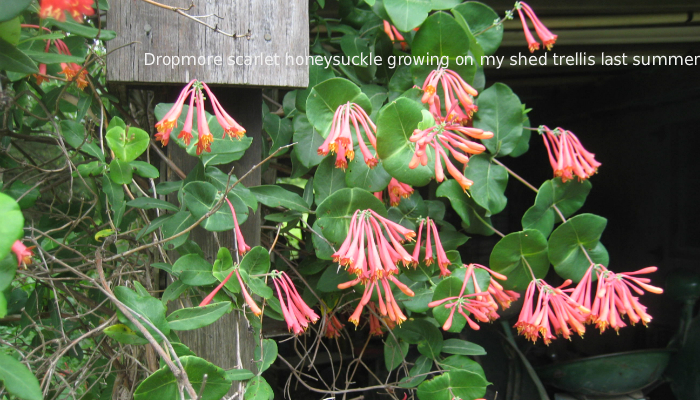A Hummingbird Honeysuckle for Your Cold Microclimate

My microclimate blogs over the past two years have tended to emphasize our warmer sites. This is because a significant part of our native flora and fauna is near the northwest limits of their native ranges, and only flourish in our milder microclimates. But many of our conservation properties also have colder microclimates. Most of these are either north-facing hillslopes with a nice winter view of the Arctic Circle, or valley bottoms where cold air drainage flows through on calm and clear winter nights. In places like these, you need plants with a zone 3 or 4 rating, instead of our average zone 5.
There are several honeysuckle vines native to the upper Midwest. Trumpet honeysuckle (Lonicera sempervirens) favors more southern landscapes and milder microclimates, while its close cousin, hairy honeysuckle (Lonicera hirsuta) handles colder microclimates and extends well north into Canada. These two interbreed readily and their assorted hybrids are lumped together as Brown’s honeysuckle (Lonicera x Brownii). Decades ago one of these hybrids was found at the horticultural experimental station at Dropmore, Manitoba, which produced the abundance of trumpet-shaped red/orange flowers of its southern parent, and had the cold tolerance of its northern parent. Marketed as the Dropmore Scarlet Honeysuckle, it has been available in nursery catalogs for about a quarter century.
I’ve grown Dropmore on a trellis on my shed for perhaps twenty years. This is a rather sheltered location, so I haven’t personally given it the real test of a colder local microclimate, and instead have to rely on places where I’ve seen it in open areas at Ames and Minneapolis. The literature says it does continue to thrive at Dropmore, Manitoba, so it is cold-hardy over the longer term.
At my place it needs nearly full sun to really thrive, and it definitely attracts hummingbirds. Occasionally in summer it is attacked by aphids, which can deform the new leaves and flower buds, unless our native ladybugs eat the aphids.
An advantage of this hybrid is that when birds eat the berries and spread the seed around, the second generation will revert back to one parent or the other, which won’t matter because both are native. So this is a durable vine that will support hummingbirds in summer and tolerate the rigors of winter.
For more information about our local microclimates as habitat, see my earlier blogs, including: Microclimates are Important to Planting in Southeast Iowa, Microclimates II: How Do They Affect Animals?, Microclimates III: How to Recognize Them in the Field, Effects of Diversity: Boom and Bust in Hummingbird Heaven, and Radiation Frost: Another Dimension of Microclimate.
Tags: honeysuckle, hummingbirds, Lon Drake, microclimate

